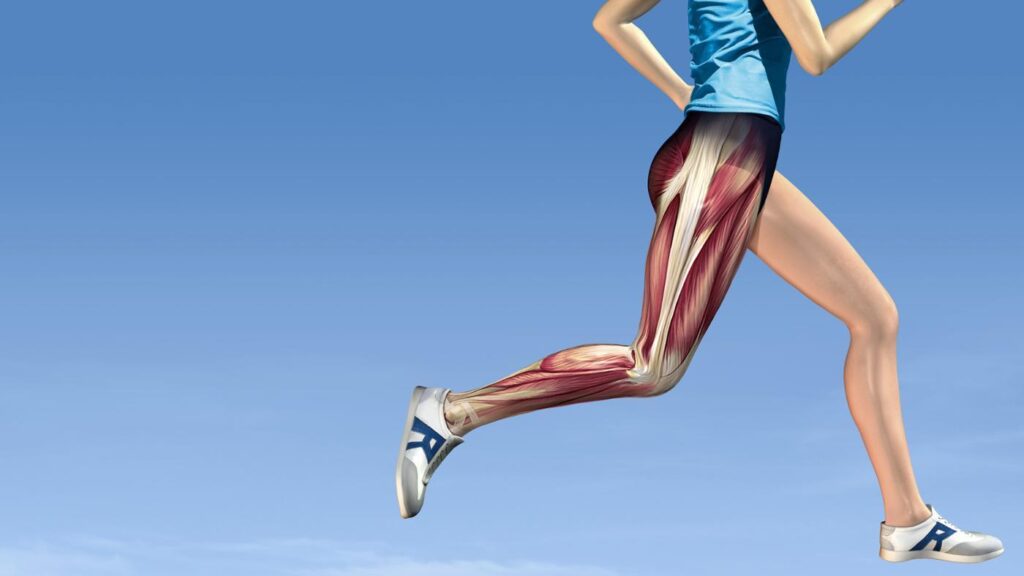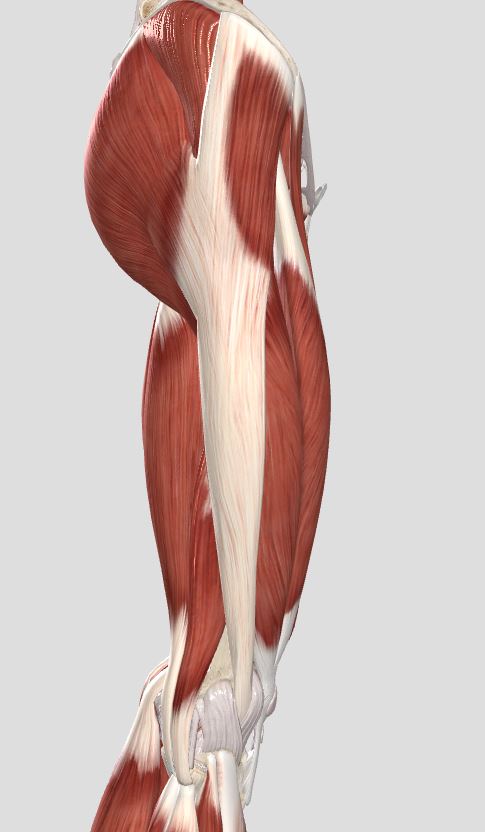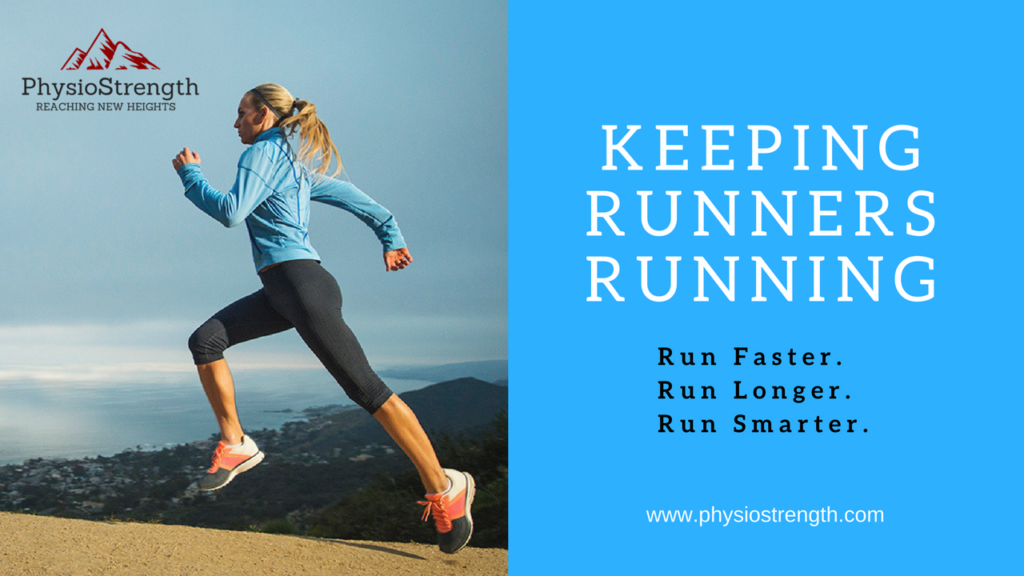ITB Syndrome in Runners

Get ready for this. I’m going to start this post off with some bold statements.
- If you think you are stretching your Iliotibial band (ITB), you’re not. As hard as you try, you cannot stretch your ITB.
- Whatever information you might have read on the internet that told you to smash your ITB repeatedly with a foam roller is doing you a disservice.
- ITB syndrome is related to increased compression and friction forces. Smashing it and rolling it are adding compression and friction.
What is the ITB?
Now that we’ve gotten those statements out of the way, let’s begin the discussion of ITB syndrome with some background as to what ITB really is. The ITB is a thick piece of connective tissue comprised of collagen. It originates at the side of your pelvis from blended fascial tissue from the gluteal muscles and the tensor fascia latae muscle (TFL). It runs down the outside of the thigh and inserts primarily onto the outside portion of your tibia (shin bone) with several other fascial connections into the hamstrings and patella (kneecap). Its main job is to create a longer lever arm for the muscles at your hip to move your leg. It also helps to provide lateral stability to the leg and knee. The ITB is unlike many other connective tissue structures because of its thickness. In comparing it to other structures in your body, it is fairly similar to the thoracolumbar fascia and the plantar fascia.
What is ITB syndrome?
ITB syndrome is a broad and generic term for lateral leg or knee pain related to the ITB. It is often seen in runners, especially runners who are either deconditioned, increase mileage too quickly, or have a significant gait deviation in their running mechanics causing biomechanical stresses to the lateral knee. The ITB most commonly becomes irritated at smaller ranges of knee flexion (around 30 degrees) when it is compressed against the lateral femoral condyle (outside portion of the thigh bone at the knee). In general, ITB syndrome is an “overuse” condition. I don’t particularly like the term “overuse” but I think it helps get the point across that the inflammation builds up over time and is activity-related. The compression and friction over time, causes an inflammatory response and is responsible for the pain experienced at the outside of the knee. Some studies have shown a fat pad beneath the insertion of the ITB and the bone, which has also been hypothesized as a potential area for irritation.
Who gets ITB Syndrome?
Technically, anyone with an ITB (or two) can get ITB syndrome. It is most commonly seen in runners due to the repetitive nature of the sport. It is a leading cause of lateral knee pain in many runners because of friction caused underneath the ITB on the lateral femoral condyle, where it can rub with repeated knee flexion and extension.
How to Treat ITB Syndrome?
We all know how to treat ITB syndrome right? Lay on your side and mash the hell out of your ITB with a foam roller. WRONG! As mentioned earlier, the inflammatory response at the lateral knee is caused by friction and compression. Adding friction and compression via the foam roller is only going to make things worse.
Now, don’t get me wrong, and interpret this as me telling you to never roll out your ITB. I have no problem with runners rolling out their ITB as a warm-up or cool-down. It is completely fine to do as long as you aren’t rolling over a bony prominence or an inflamed area. What I do have a problem with is runners who believe that foam rolling their ITB is going to loosen it up by stretching the fibers out. It’s even a stretch to say that foam rolling loosens muscle fibers, let alone the thick collagen fibers found in the ITB. Foam rolling works by stimulating sensory receptors in the skin that can help provide pain modulation and decreased the resting tone of the muscle, not my mashing up your tissues and loosening them up. If you want to learn more about foam rolling, please check out my previous post about it here.
Okay, so if foam rolling the ITB doesn’t work, perhaps it’s best to just stretch it out? NOPE! If anyone knows of a study in which the length of the ITB was increased via stretching, please show me. There have been cadaver studies that put extreme tensile forces on the ITB even under long duration and still did not yield a lengthening effect. There is no stretch or no amount of human force that could lengthen your ITB.
If foam rolling and stretching the ITB aren’t the answer, what is? As mentioned previously, the ITB is comprised of fascial connections between the gluteal muscles and the TFL muscle. What can have a positive effect is stretching these two muscles. Even better, there are manual techniques that your physical therapist can perform to help loosen these muscles up and gain better mobility through the hip region. This will, in turn, offload stresses on the knee.
With all of that said, the best way to treat ITB syndrome is to determine the cause. I’m not talking about the compression and friction components. There is a reason this condition arises. Perhaps you are a runner and have been running for 2 years without pain. Then, all of a sudden, you develop this ITB syndrome pain at the lateral knee. It’s not just a random occurrence. It usually has to do with running mechanics, footwear, errors in training programming, training volume or recovery, or a combination of these factors. Each patient is different. There is no one-size-fits-all approach to treating any medical condition. Sure, you can find things on the internet that may help. However, the best start on the road to recovery involves getting a proper diagnosis from a qualified movement expert such as your Doctor of Physical Therapy. Most of the time, these “overuse” type injuries are not as cut and dry as we would like them to be. There are typically underlying movement dysfunctions and certain muscular impairments that are leading to increased stresses in certain regions of the body. A good physical therapist who truly understands biomechanics and the influence of ground reaction forces during running can help determine the cause of your specific condition and develop an individualized treatment plan to help you get better.
Please feel free to reach out to me at PhysioStrength Physical Therapy if you are experiencing any pain or injury that is interfering with your daily activities. I’m happy to help. If you are a runner and would like to improve your running performance, learn to manage running injuries and develop your own training program, please check out my online running workshop, “Keeping Runners Running.” Enjoy!
I would love to hear your thoughts, comments, and questions. Feel free to comment below with any feedback, good or bad. Lastly, please feel free to share this post with friends, family, or anyone else you know who might benefit from reading it. Thanks!
Sincerely,
Dr. Connor Naccarato DPT, MTC, CSCS



